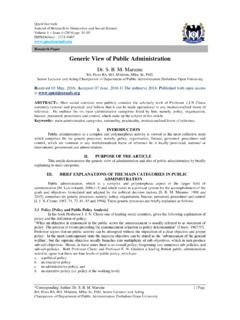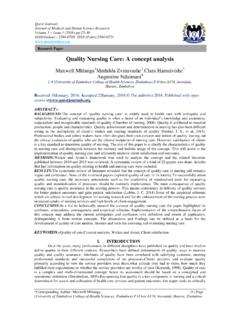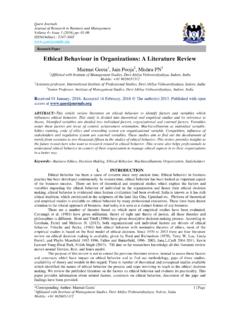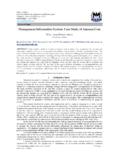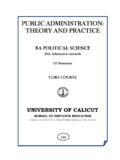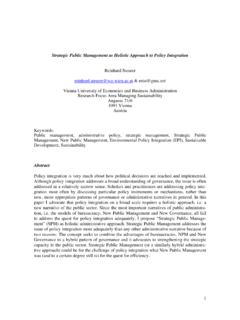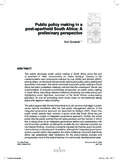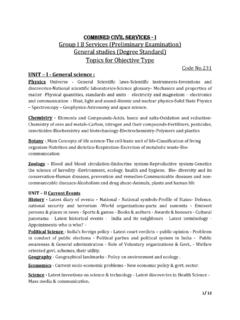Transcription of Centralization and Decentralization - Quest Journals
1 Quest Journals Journal of Research in Humanities and social Science Volume 4 ~ Issue 6 (2016) pp: 106-110 ISSN(Online) : 2321-9467 *Corresponding Author: Dr. S. B. M. Marume1 106 | Page 1BA, Hons BA, MA, Madmin, Msocsc, Phd Research Paper Centralization and Decentralization Dr. S. B. M. Marume1, R. R. Jubenkanda2, 1BA, Hons BA, MA, Madmin, Msocsc, Phd 2bsc, Msc. Econ, Msc, Dphil (Candidate) Zimbabwe Open University Received 22 June, 2016; Accepted 02 July, 2016 The author(s) 2014. Published with open access at ABSTRACT: In this article, the two concepts, namely, Centralization and decentralisation, are defined and explained in order to give differences and similarities between these two terms.
2 Keywords: Centralization and Decentralization ,definition and explanation, differences and similarities. I. INTRODUCTION The term Centralization means concentration of authority at the top of the administrative system. On the one hand, and, on the other hand, Decentralization means dispersal of authority among the lower levels of the administrative system. II. PURPOSE OF THE ARTICLE To define and explain the concept of Centralization and Decentralization . III. Centralization AND Decentralization Meanings: Centralization means concentration of authority at the top level of the administrative system. Decentralization , on the other hand, means dispersal of authority among the lower levels of the administrative system. Thus, the issue of Centralization versus Decentralization revolves around the location of the decision making power in the administrative system.
3 In a centralized system of administration, the lower levels (called field offices) cannot act on their own initiative. They have to refer most of their problems to the higher level (called headquarters) for decision-making. They act as only implementing agencies. In a centralized system of administration, on the other hand, the field offices can act on their own initiative in specified matters. They are given authority to take decisions without reference to the headquarters. Thus, the essence of Decentralization is the vesting of decision-making power in the field offices. Centralization is the opposite of Decentralization . It means Centralization of authority once decentralized. The word Decentralization is derived from Latin. Definitions The following definitions can be noted in this regard: White: The process of transfer of administrative authority from a lower to a higher level of government is called Centralization ; the converse, Decentralization .
4 Henry Fayol: Everything that goes to increase the importance of the subordinate s role is Decentralization ; everything which goes to decrease it is Centralization . Typologies of Decentralization Broadly, Decentralization is of the two types political and administrative. The Decentralization is further sub-divided into territorial (vertical) Decentralization and functional (horizontal) Decentralization . A brief discussion of the typologies of Decentralization is as follows: Centralization And Decentralization *Corresponding Author: Dr. S. B. M. Marume1 107 | Page a) Political Decentralisation: It stands for the establishment of new levels of government like the autonomous states in India or provinces in Canada.
5 In the federal systems, political authority is divided between central government and the regional governments (State governments in India or Provincial governments in Canada). The creation of autonomous local governments in Federal States like USA or India and in Unitary States like Britain or Japan also implies political Decentralization . Thus the establishment of City Governments in USA, Panchayati Raj and Municipal Corporations in India, County Governments in Britain and Prefectural Governments in Japan are good examples of political Decentralization . b) Territorial Decentralisation: It stands for the establishments of area administrative units (field offices) by the higher authority (headquarters). For example, the creation of divisions, districts, talukas, circles, and so on in India.
6 These are vested with decision-making powers within specified limits and thus function in an independent manner. c) Functional Decentralisation: It implies the vesting of decision-making authority in the specialized units by the central agency. For example, the creation of technical or professional bodies in India like the University Grants Commission, Flood Control Board, Central social Welfare Board, and so forth. Approaches to Decentralization James W. Fesler classified the different approaches to the concept of Decentralization in the following four categories: a) Doctrinal Approach: It conceives Decentralization as an end in itself and not as a means to the realization of some goal. It views Decentralization in terms of idealization, that is, a theory which holds that things exist only as ideas in the mind.
7 B) Political Approach: It says that the creation of decentralized units with a set of operational autonomy is governed by political factor. For example, the creation of Panchayati Raj as a rural local self-governing body in our country is politically determined. c) Administrative Approach: It says that the establishment of autonomous decentralized units in the fields is determined by the factor of administrative efficiency, that is, better decision-making and faster problem-solving. For example, the creation of regions, divisions, districts, sub-divisions, talukas and circles between the state headquarters and the field. d) Dual-role Approach: It conceives Decentralization as a method of resolving conflicts in field administration between tradition and change.
8 The usage of status-quo oriented colonial field administration to bring about speedy socio-economic change is leading to area-function dichotomy in district administration in our country. Merits of Centralisation These are briefly discussed as follows: a) It provides for maximum control over the entire organization. b) It ensures that all the work is performed in the same manner and in accordance with the same general policies and principles. c) It makes administrative abuses more difficult in matters like employment and handling of personnel, purchase and use of supplies and so on. d) It ensures economy in administration by avoiding duplication of work. e) It facilitates the introduction of dynamism in the organization through the active role of personnel leadership.
9 F) It is suitable for dealing with emergencies and unanticipated matters. g) It enables the maximum utilization of the human and material resources in the organization and thus develops a corporate personality. Demerits of Centralisation These are provided as follows: a) It leads to delay in securing action as the field officials have to refer the matter to the higher authorities. b) It makes the head-office overburdened due to apoplexy at the top and anemia at the extremities. c) It leads to autocratic control over subordinates and thus results in lack of flexibility in administration. d) It makes administration irresponsive as the head office acts without the knowledge of local conditions and requirements. Centralization And Decentralization *Corresponding Author: Dr. S. B.
10 M. Marume1 108 | Page e) It does not facilitate people s participation in administrative process. f) It does not allow the development of second line of executives. g) It is not conducive for the expansion and diversification of the organization. Merits of Decentralisation These are stated as follows: a) It increases administrative efficiency by reducing delays, curbing red-tapism and encouraging faster action. b) It reduces the workload of the head office and thus enables the top echelons to concentrate on vital issues like policy formulation, examining major problems and so forth. c) It develops resourcefulness and self-respect among the subordinates by making them to take decisions with a sense of responsibility.
